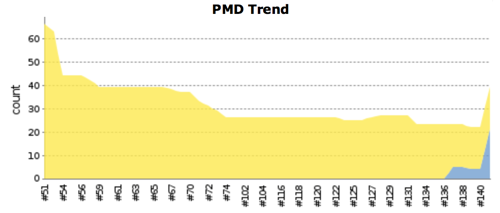OCLint is a static code analyzer for C, C++ and Objective-C. You’ll find it here on GitHub.
Today the maintainer merged my pull request in which I made an additional reporter module which writes a PMD-style file.
Having that, you can let the PMD Analysis run by Jenkins reports about your coding sins.

Here’s how to set the whole thing up:
1. Setup OCLint
- Get the latest source code from GitHub
- Follow the instructions to build OCLint
- Install it.
2. Build file for Jenkins
The invocation of OCLint is configured in a build.xml. I’ll walk you through this one.
<?xml version="1.0" encoding="UTF-8"?>
<project name="fooProject" default="build-fooProject">
<property environment="env"/>
<target name="build-fooProject" depends="prepare,oclint" />
<target name="clean" description="Cleanup build artifacts">
<delete dir="${basedir}/build/oclint" />
</target>
<target name="prepare" depends="clean" description="Prepare for build">
<mkdir dir="${basedir}/build/oclint" />
</target>
Standard stuff so far. Setup the project and prepare the directories.
<target name="oclint">
<antcall target="xcodebuild-clean" />
<antcall target="xcodebuild" />
<antcall target="oclint-xcodebuild" />
<antcall target="oclint-parse" />
</target>
Our oclint invocation has four steps.
<target name="xcodebuild-clean">
<exec executable="xcodebuild">
<arg value="-configuration" />
<arg value="Release" />
<arg value="clean" />
</exec>
</target> This ensures, that we have a clean build.
<target name="xcodebuild">
<exec executable="xcodebuild" output="xcodebuild.log">
<arg value="-configuration" />
<arg value="Release" />
<arg value="-arch" />
<arg value="armv7" />
<arg value="CODE_SIGN_IDENTITY=" />
<arg value="CODE_SIGNING_REQUIRED=NO" />
</exec>
</target> Now we build our project. The important part is `output="xcodebuild.log"`; this will write the output to a file which will be fed to a helper script in the next step.
<target name="oclint-xcodebuild">
<exec executable="PATH_TO_oclint-release/bin/oclint-xcodebuild" />
</target>
oclint-xcodebuild reads the xcodebuild.log and produces the file compile_commands.json. This file holds all the compiler stuff and is the input format for oclint.
<target name="oclint-parse">
<exec executable="PATH_TO_oclint-release/bin/oclint-json-compilation-database">
<env key="PATH" value="${env.PATH}:PATH_TO_oclint-release/bin/"/>
<arg value="--" />
<arg value="-o=${basedir}/build/oclint/lint.xml" />
<arg value="-report-type=pmd" />
<arg value="-stats" />
</exec>
</target>
</project> Finally, this is where the magic happens. `oclint-json-compilation-database` feeds the `compile_commands.json` file to `oclint`. The `-report-type=pmd` flag tells it to use the PMDReporter, which will write its findings to a file called `lint.xml`.
Be sure to consult the documentation for OCLint and its helpers for the various arguments you can provide.
I created a gist with the whole file here.
3. Configure the job in Jenkins
- Go to the configuration page of your job in Jenkins.
- Add a build-step with the build.xml
- Add a post-build action “Publish PMD analysis results” and enter the path to the xml file we produced. In this example it would be
build/oclint/lint.xml
4. Build the job
If everything worked, you should have a new section “PMD Warnings” in your build information and after a few builds the trend chart will be produced.